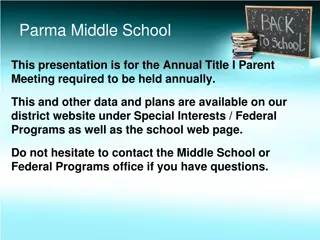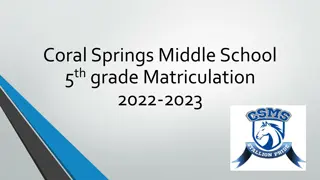
Understanding Motion and Speed in Physics
This content covers fundamental topics related to motion and speed in physics, focusing on concepts like frames of reference, distance, displacement, speed, velocity, and calculating speed. It explains how a frame of reference is used to describe motion, the distinction between speed and velocity, and the methods to study and calculate these quantities. The visuals aid in comprehending the concepts of displacement, average speed, and instantaneous speed.
Download Presentation

Please find below an Image/Link to download the presentation.
The content on the website is provided AS IS for your information and personal use only. It may not be sold, licensed, or shared on other websites without obtaining consent from the author. If you encounter any issues during the download, it is possible that the publisher has removed the file from their server.
You are allowed to download the files provided on this website for personal or commercial use, subject to the condition that they are used lawfully. All files are the property of their respective owners.
The content on the website is provided AS IS for your information and personal use only. It may not be sold, licensed, or shared on other websites without obtaining consent from the author.
E N D
Presentation Transcript
Prior Physics Knowledge Review WHAT DO YOU REMEMBER FROM MIDDLE SCHOOL SCIENCE CLASS
Speed How is a frame of reference used to describe motion? What is the difference between speed and velocity? What do you need to know to find the speed of an object? How can you study speed by using graphs?
Observing Motion How is a frame of reference used to describe motion? When an object changes position with respect to a frame of reference, the object is in motion. motion: an object s change in position relative to a reference point frame of reference: a system for specifying the precise location of objects in space and time
Observing Motion, continued Distance measures the path taken. Displacement is the change of an object s position. always includes direction In the diagram: yellow line = distance black arrow = displacement
Speed and Velocity What is the difference between speed and velocity? Speed tells us how fast an object moves, and velocity tells us both the speed and the direction that the object moves. speed: the distance traveled divided by the time interval during which the motion occurred velocity: the speed of an object in a particular direction
Speed and Velocity, continued Velocity is described relative to a reference point. Direction is described as positive or negative along the line of motion. By convention, up and right are usually positive, and left and down are negative. Combined velocities determine the resultant velocity.
Calculating Speed What do you need to know to find the speed of an object? To calculate speed, you must measure two quantities: the distance traveled and the time it took to travel that distance.
Calculating Speed, continued Average speed is calculated as distance divided by time. distance speed = tim e d t = , or v SI unit for speed: meters per second (m/s) constant speed: equal distances in equal amounts of time instantaneous speed: thespeed at a given time
Math Skills Velocity Metal stakes are sometimes placed in glaciers to help measure a glacier s movement. For several days in 1936, Alaska s Black Rapids glacier surged as swiftly as 89 meters per day down the valley. Find the glacier s velocity in m/s. Remember to include direction. 1. List the given and the unknown values. Given: time,t = 1 day distance,d = 89 m down the valley Unknown: velocity, v = ? (m/s and direction)
Graphing Motion, continued Motion can be studied using a distance vs. time graph. time (x-axis) = independent variable distance (y-axis) = dependent variable The slope of a distance vs. time graph equals speed.
Acceleration What changes when an object accelerates? How do you calculate the acceleration of an object moving in a straight line? How can a graph be used to find acceleration?
Acceleration and Motion What changes when an object accelerates? When an object undergoes acceleration, its velocity changes. acceleration: the rate at which velocity changes over time; an object accelerates if its speed, direction, or both change
Acceleration and Motion, continued Acceleration can be a change in speed. An increase or decrease in speed is an acceleration. Acceleration can also be a change in direction. A motorcyclist who rides around the inside of a large barrel is constantly accelerating. A person riding a Ferris wheel at an amusement park is accelerating. The acceleration that occurs in circular motion is known as centripetal acceleration.
Calculating Acceleration How do you calculate the acceleration of an object moving in a straight line? The average acceleration over a given time interval can be calculated by dividing the change in the object s velocity by the time over which the change occurs. ??????? ???????????? =????? ???????? ?????? ???????? ???? ?? ?? ? = ? ? = ?
Math Skills Acceleration A flowerpot falls off a second-story windowsill. The flowerpot starts from rest and hits the sidewalk 1.5 s later with a velocity of 14.7 m/s. Find the average acceleration of the flowerpot. 1. List the given and the unknown values. Given: time,t = 1.5 s initial velocity,vi = 0 m/s final velocity,vf = 14.7 m/s down Unknown: acceleration, a = ? (m/s2 and direction)
Graphing Accelerated Motion, continued Acceleration can also be seen on a distance vs. time graph. The distance vs. time graph is not a straight line when the velocity is not constant. This curved line indicates that the object is under acceleration.
Force What do scientists identify as the fundamental forces of nature? What happens when there is a net force acting on an object? What force always opposes motion? Why is friction sometimes necessary?
Fundamental Forces What do scientists identify as the fundamental forces of nature? These forces are the force of gravity, the electromagnetic force, the strong nuclear force, and the weak nuclear force. The strong and weak nuclear forces act only over a short distance. The force of gravity is a force that you feel every day. Other everyday forces, such as friction, are a result of the electromagnetic force.
Fundamental Forces, continued Fundamental forces vary in strength. The fundamental forces vary widely in strength and the distance over which they act. Forces can act through contact or at a distance. Pushes and pulls are examples of contact forces. Field forces (like the force of gravity) do not require that the objects touch each other. Both contact and field forces can cause an object to move or to stop moving.
Balanced and Unbalanced Forces What happens when there is a net force acting on an object? Whenever there is a net force acting on an object, the object accelerates in the direction of the net force. net force: the combination of all forces acting on an object
Balanced and Unbalanced Forces, continued Balanced forces do not change motion. Forces are balanced when the net force is zero. Example: For a light hanging from the ceiling (at rest), the upward force due to tension in the cord balances the downward force of gravity.
Balanced and Unbalanced Forces, continued Unbalanced forces do not cancel completely. Forces are unbalanced when the net force is greater than zero. The object will accelerate in the direction of the net force. Example: If you push a box to the east and your friend pushes the box to the north, the box will accelerate in a northeasterly direction.
The Force of Friction What force always opposes motion? The force of friction always opposes the motion. friction: a force that opposes motion between two surfaces that are in contact
Friction and Motion Why is friction sometimes necessary? Friction is necessary for many everyday tasks to work correctly.
Friction and Motion, continued Unwanted friction can be lowered. using low-friction materials, such as nonstick coatings on cooking pans using lubricants, such as motor oil, wax, and grease Helpful friction can be increased. scattering sand on icy roads to keep cars from skidding wearing textured batting gloves when playing baseball to make it easier to grip the bat
Friction and Motion, continued Cars could not move without friction. Without friction between the tires and the road, the tires would not be able to push against the road and the car would not move forward. The force pushing the car forward must be greater than the force of friction that opposes the car s motion. Because of friction, a constant force must be applied to a car just to keep it moving at the same speed.






















